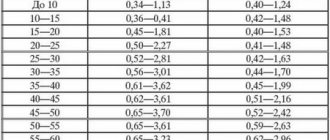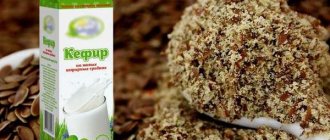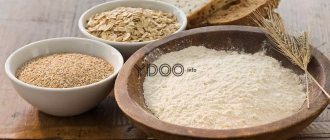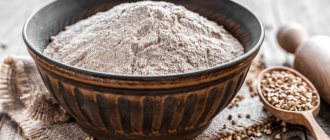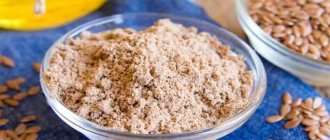Coconut flour
Coconut flour is a gluten-free flour made by grinding dried coconut meat into a soft, fine powder.
It is higher in calories than traditional grain flour and is a good source of protein, fat, fiber and minerals such as iron and potassium.
Unlike grain flour, coconut flour contains a significant amount of fat. This fat is mostly saturated and predominantly composed of medium chain triglycerides (MCTs), which can reduce inflammation and support healthy metabolism (,).
Although it is controversial, saturated fat from coconuts likely affects your health differently than fast food, fried foods, and animal products, and may even be beneficial (,).
Coconut flour also contains high levels of antioxidants and has antimicrobial properties ().
A 65 gram serving contains ():
- Calories : 210 kcal
- Protein : 8.5 grams
- Fat : 13 grams
- Carbohydrates : 34 grams
- Fiber : 25 grams
- Iron : 22% of recommended daily intake (RDI)
- Potassium : 18% of RDI
Coconut flour has a mild, sweet flavor that is suitable for cakes, cookies, breads and other baked goods.
It has a grainy texture and absorbs a lot of liquid, which can cause baked goods to dry out. Thus, it is best suited for dishes that rely on eggs to maintain moisture and structure, such as muffins.
When substituting coconut flour for wheat flour, use about 1/4 of what the recipe calls for, then replace the remaining 3/4 with another type of flour.
Also, since it requires more liquid than other flours, add 1 egg for every 1/4 cup (30 grams) of coconut flour in baked goods.
Conclusion:
Coconut flour is gluten-free and a good source of fat, protein, fiber and antioxidants. Its mild, sweet flavor is best suited for baked goods such as cakes, cookies and muffins.
Almond flour
Almond flour is made by grinding blanched almonds into a fine powder. Because it is grain-free, it is naturally gluten-free.
Note that almond flour is different from almond nibs, which is a coarser ingredient made by grinding almonds with their skins intact.
Almond flour is a good source of magnesium, omega-3 unsaturated fats, plant protein and vitamin E, a powerful antioxidant. Keep in mind that almonds, like other nuts and seeds, are high in calories.
The nutrients in this flour provide a variety of benefits to your health, including reduced insulin resistance as well as lower LDL (bad) cholesterol and blood pressure. Almonds may also protect brain health, as vitamin E may reduce the risk of developing Alzheimer's disease (, , , , ).
A 55 gram serving of almond flour contains ():
- Calories : 340 kcal
- Protein : 12 grams
- Fat : 30 grams
- Carbohydrates : 12 grams
- Fiber : 4 grams
- Calcium : 5% of RDI
- Iron : 6% of RDI
- Potassium : 8% of RDI
- Magnesium : 65% of RDI
- Vitamin E : 100% of RDA
Almond flour has a nutty flavor and is easy to use. In most recipes, you can simply replace the wheat flour with almond flour in an equal ratio.
It works well in pancakes, cookies, muffins and biscuits, and can also be used in some savory foods such as homemade pasta and meatballs.
Conclusion:
Almond flour is grain-free and gluten-free, and is a good source of protein, unsaturated fat, magnesium and vitamin E. Its nutty flavor is suitable for a wide range of baked goods and savory dishes.
Benefits and harms of the product
Any flour carries a lot of useful substances for the body. It is worth listing the main ones:
- 100 g of product contains so much iron that it covers the daily requirement by 32%. And iron is involved in providing all cells of the body with oxygen. The fact is that iron is the leading component of the hemoglobin molecule - a protein of red blood cells (erythrocytes), which binds to oxygen and transports it in bound form to all tissues of the body.
- With bread for breakfast, lunch and dinner we get 10% of our daily calcium requirement.
- Flour contains vitamins B and PP. And they are necessary for the normal functioning of the nervous, muscular, and digestive systems.
- Flour has Omega-3 and 6 fatty acids, which are needed for beautiful hair, nails, skin, and well-being. In addition, these substances can reduce the concentration of bad cholesterol in the body, which disrupts the functioning of the cardiovascular system.
WHO recommends that everyone consume at least 25 g of bread per day. But it is better that these are products made from wholemeal flour. It is the most useful, it contains a lot of fiber.
Expert opinion
Evgeniy Kislitsa
Practicing surgeon. Certified massage master. Two-time vice-champion and heavyweight champion of regional kettlebell lifting competitions.
Fiber is a hard-to-digest dietary fiber. The bottom line is that it is little susceptible to the influence of food enzymes, which is why it is poorly digested. The benefits of fiber are pronounced for the intestines. As it passes through the intestines, it affects its walls, thereby increasing their tone. And this leads to improved motility (periodic rhythmic contractions of the intestinal wall) of the organ, which improves digestion. Also, adequate fiber intake is a reliable method of preventing constipation. In addition to the above, fiber has a beneficial effect on intestinal microflora. The fact is that both beneficial and harmful bacteria live in the intestinal lumen. Fiber, passing through the intestines, “washes out” harmful bacteria from it. After which it becomes easier for beneficial microorganisms to reproduce (after all, the population of their competitors decreases). Thanks to this property, fiber is not only able to normalize digestion in the intestines, but also prevent many diseases of the organ. In medicine, due to this property, fiber is used to treat dysbiosis and a number of diseases of the digestive system. In addition, fiber affects the stretch receptors of the stomach wall, due to which it allows you to get full faster and not feel hungry for a long time.
You may also be interested in: Healthy Bread Recipe
Unfortunately, there is also harm, but it is not caused by the product itself, but by the amount of use.
What does it consist of:
- High calorie content, so a large amount of bread is dangerous for your figure. Especially when it comes to muffins and cakes.
- Contains vegetable gluten protein, which can cause bloating and diarrhea in particularly sensitive people. With long-term gluten consumption, people who are sensitive to it can develop severe inflammatory bowel disease. And for those suffering from celiac disease, long-term consumption of foods containing gluten can lead to severe organic intestinal lesions that are difficult to treat.
White bread is also of little use, but can only cause flatulence and belching. Moreover, it is the most high-calorie of all types of bread.
Important! There is an opinion that modern industrial yeast used in baking bread is harmful to the body. In fact, they die at temperatures above 60 degrees. And when baking bread in an oven at 200 degrees, not a trace of microorganisms remains.
Be sure to check out:
Is it possible to eat corn while on a diet: benefits and harms? Get a complete set of proteins, fats and carbohydrates from Doshirak dietary products on a diet: is it possible to eat fast food products? Is it possible to eat soy sauce while on a diet: all the myths and truth
Quinoa flour
Quinoa flour is made by grinding quinoa into a fine powder.
This pseudocereal is gluten-free and considered a whole grain—meaning it has not been processed or refined, leaving its original nutrients intact.
Notably, this flour is a good source of protein, fiber, iron and unsaturated fat. In addition, it has antioxidant and anti-inflammatory properties that may improve digestive health, inhibit tumor growth, and reduce the overall risk of disease (, ).
A 55 gram serving of quinoa flour contains ():
- Calories : 200 kcal
- Protein : 8 grams
- Fat : 2 grams
- Carbohydrates : 38 grams
- Fiber : 6 grams
- Iron : 33% of RDI
- Potassium : 4% of RDI
Quinoa flour gives baked goods a moist, tender texture. You can substitute quinoa flour for the wheat flour in most recipes, using only half the amount needed.
Some people find this flour bitter, but you can reduce the aftertaste by toasting it in a dry skillet over medium heat for 5 to 10 minutes, stirring gently, before adding it to your recipe.
Quinoa flour is great for pancakes, muffins, pizza and pies. You can also use it to thicken soups and sauces.
Conclusion:
Quinoa flour is a gluten-free grain flour that is high in protein, iron, fiber and unsaturated fat. It adds a fluffy texture to baked goods, is great for pizza and pies, and serves as a thickener for soups and sauces.
Is it possible to have flour on a diet?

You don't have to give up flour completely. Some flour products can be consumed on a diet without harm. You just need to strictly control the quantity, and also follow the following rules:
- try to eat flour in the first half of the day;
- choose pasta from durum wheat;
- It is advisable to eat yesterday’s bread rather than fresh pastries;
- also, instead of fresh bread, it is better to use dried bread in an oven, microwave, or toaster;
- It is better to eat bread made from wholemeal flour. But you can eat such bread only in the absence of inflammatory diseases of the stomach and intestines (for example, gastritis, duodenitis, gastric ulcer and/or duodenal ulcer);
- eat no more than two pieces per day.
By the way, classic pasta can be replaced with a product without flour - funchose, which can be eaten on a diet.
However, during heavy physical activity, you can sometimes allow cakes and buns. This will not cause you to gain kilograms. After all, calories consumed in food are quickly used up to cover the body’s energy needs, which increase significantly with intense physical activity.
But you can treat yourself to such sweets once every two to three weeks.
You may also be interested in: Is it possible to dry while dieting?
To build muscle mass, you need to eat carbohydrates every day, the share of which is up to 60% of the daily food volume. And bread and pasta are carbohydrates.
Interesting! The biggest consumers of bread are Russians and Americans. In the daily diet it averages 18%. All countries and every people have something floury in their national cuisine. The most common flour is wheat flour.
Buckwheat flour
Buckwheat flour is made from ground buckwheat, a plant known for its grain-like seeds. Buckwheat is a pseudocereal and does not contain gluten.
Buckwheat flour has an earthy flavor and is used to make traditional Japanese soba noodles. It is a good source of fiber, protein and micronutrients such as manganese, magnesium, copper, iron and phosphorus.
Research shows that this flour may lower blood sugar levels in people with diabetes and improve biomarkers of heart health. It may also have anti-cancer, anti-inflammatory and prebiotic properties (, ,).
Prebiotics are a type of fiber that feeds the good bacteria in your gut that keep your digestive tract healthy ().
A 60-gram serving of buckwheat flour contains ():
- Calories : 200 kcal
- Protein : 4 grams
- Fat : 2 grams
- Carbohydrates : 44 grams
- Fiber : 6 grams
- Iron : 17% of RDI
- Manganese : 34% of RDI
- Magnesium : 33% of RDI
- Copper : 73% of RDI
- Phosphorus : 17% of RDI
For best results, buckwheat flour should be used in combination with other whole grain flours and should make up 25-50% of the total flour in the recipe.
It works well for making pancakes and quick breads, and is great as a breading for meats or other protein foods.
Conclusion:
Buckwheat flour is rich in fiber, protein and numerous minerals. Known for its use in soba noodles, it also makes a tasty addition to baked goods and is used as a breading.
Rice
Ground rice flour is a fairly high-calorie product due to the starch it contains. It is this that makes the dough more pliable and sticky. It is good for making cookies, crispbreads, Japanese rice bread and flatbreads. The products are crispy and odorless. Rice has almost no fat and a minimum of proteins, but 80 g of carbohydrates per 100 g. Rice flour is rich in potassium, calcium and magnesium.
When losing weight, rice products are useful because with the help of this cereal, excess fluid is removed from the body. But you shouldn’t get carried away with baking, since any type of rice contains a lot of gluten and carbohydrates. For weight loss, it is better to choose brown rice, unpeeled. The bran it contains is rich in fiber, which reduces appetite for a long time.
Whole wheat flour
Wheat flour is found in most baked goods that you find in bakeries and supermarkets.
However, whole wheat and white flour are very different. While whole wheat flour is made by grinding whole wheat grains into a powder, the white flour manufacturing process removes the most nutrient-rich parts - the bran and germ ().
Thus, whole wheat flour is considered healthier.
It is a good source of protein, fiber and various vitamins and minerals. Because it contains gluten, it is not suitable for people with celiac disease or gluten intolerance.
A 60 gram serving of 100% whole grain wheat flour contains ():
- Calories : 200 kcal
- Protein : 8 grams
- Fat : 0 grams
- Carbohydrates : 42 grams
- Fiber : 8 grams
- Iron : 11% of RDI
- Potassium : 5% of RDI
Whole wheat flour can be used in equal amounts as white or all-purpose flour in any recipe. Keep in mind that it produces a less fluffy texture than white flour because it is unrefined.
You can use it in making homemade bread, muffins, pies, cookies, muffins, pizza dough, pancakes and waffles.
Conclusion:
Whole wheat flour is rich in protein, fiber and some minerals, especially compared to refined white flour. It is extremely versatile and can be used for a variety of baked goods.
Summarize
Healthy flour is more widely available today than ever before.
Traditional flours are made from wheat, but many others are made from nuts and natural gluten-free grains such as coconut, quinoa, almonds and buckwheat. Each type offers a unique flavor and nutritional profile.
To find the flour that best suits your recipes, you can experiment with different types. The ratio of white flour to other flours will not always be 1:1, so be sure to take this into account when you bake.

